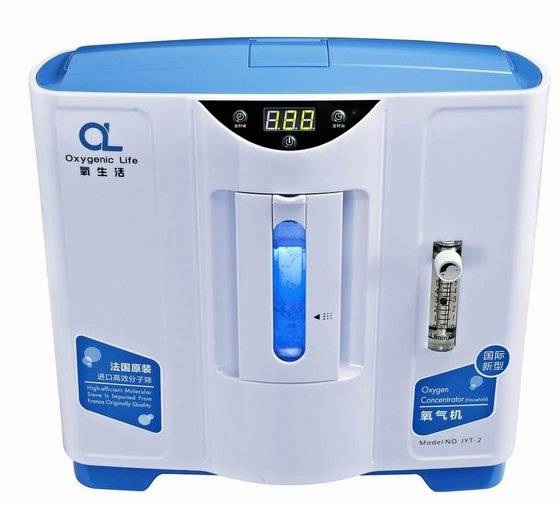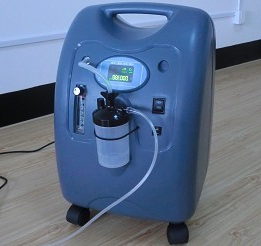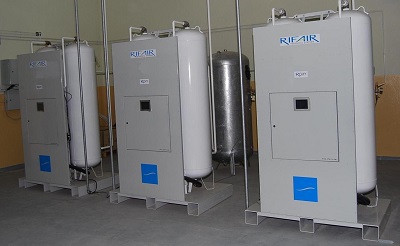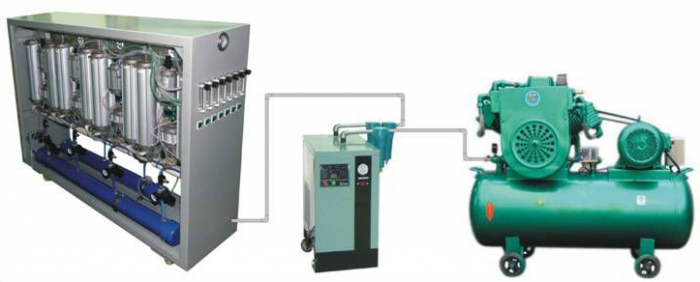 In our daily lives, we often come across the assertion that someone takes money literally from nowhere, as if scooping them up from the air.
In our daily lives, we often come across the assertion that someone takes money literally from nowhere, as if scooping them up from the air.
But few people take such a bold statement literally. But do not try to do it?
Indeed, the production of oxygen is quite a real business for itself, and besides, it gives its owner excellent profits.
The inhabitants mistakenly believe that pure oxygen can be used only by some branches of heavy industry and medical institutions, but this is completely not so.
By the way, large enterprises are much more interested in the production of liquid oxygen, which it is simply unprofitable to deal with an average medium damage due to the high danger of the process and constant inspections of regulatory authorities.
Where is oxygen used?
Yes, heavy industry actually consumes at least 80% of all oxygen produced. In addition, it is widely used by welders for acetylene-oxygen cutting of metal, for disinfecting water (due to its excellent oxidizing properties), as well as for aeration of ponds when breeding fish in winter (to prevent pestilence).
However, if you have at least one more or less functioning metal smelting plant nearby, then you will be provided with work anyway.
Unfortunately (and fortunately for the environment), such enterprises are not even in all major cities, not to mention the province. However, this should not stop you: if your region has at least some industry, fish farms or just the proper number of welders, there will always be profit.
Documents and product requirements
There are several standards that regulate the production of oxygen. It is about GOST 5583-78 and TU (technical regulations) 2114-001-05798345-2007. And even the export version of the product must be certified according to ISO 2046-73.
Note that there is no transcendent bureaucratic red tape at the stage of obtaining all the necessary documents. By the way, which papers do you need to receive?
Here is their complete list.
- Application for the right to engage in the production of gaseous oxygen.
- Notarized copies of all constituent documents of your company.
- A notarized copy of the document on registration of your company and registration of you as a legal entity.
- Required statistics codes.
- A certified copy of the extract from the register.
- All documents confirming the right of the company's specialists to engage in oxygen production: diplomas of higher and secondary specialized education, certificates of attendance at relevant courses, work books with notes on work experience at industrial enterprises of a similar profile.
- Documents confirming the fact that you have buildings that are suitable for organizing a workshop in which you can set up oxygen production (sales contract, lease agreement).
Technology and equipment
The main device for obtaining chemically pure substances is an oxygen concentrator. Some mistakenly call it a “generator", which is fundamentally wrong: it does not generate oxygen, but only extracts it from the air, increasing the concentration.
As you might guess, the cost of such equipment is directly dependent on its capacity.Productivity is measured in that amount of oxygen of the set concentration which the device will give out for one hour of work at full load.
Consider the cost of buying it: an ordinary Chinese concentrator, producing ten cubic meters of 96% oxygen per hour, will cost you six thousand dollars.
Now get ready: a generator of the same company, but already issuing a hundred cubic meters of gas of the same quality (for the same time), you have to buy for 30 million (!) Rubles. However, equipment of this class has one indisputable advantage: it can produce oxygen and nitrogen. The latter is readily purchased by agricultural enterprises engaged in the production of nitrogen fertilizers.
Additional costs and notes
Unfortunately, it will not work to install equipment in a clean alpine meadow: power is supplied from cylinders with compressed air, which was passed through powerful filters, and therefore cleaned of impurities and water vapor.
There is a positive side: you can pump pure oxygen into used cylinders from under the air. Given that one such cylinder costs about 6 thousand rubles, the savings are significant. But we would recommend buying not only oxygen production equipment, but also everything you need to clean and compress the air.
Given the above prices, you won’t even notice much difference when buying the whole kit.
The ratio of consumed air and oxygen produced
In order to also deal with air production (remember what we talked about at the beginning of the article), you need to purchase a compressor with a large reserve capacity. This equipment for the production of oxygen is not too expensive, but because the increase in productivity will not hit your pocket.
Of course, the concentrator will consume much more air compared to the chemically pure oxygen it produces. The generator mentioned above (for 10 cubic meters of finished gas) consumes 132 cubic meters of air in one hour. Accordingly, a model for 100 cubic meters will “eat” 1320 cubic meters in one hour.
Air purification and dehumidification equipment
We have already said that the production of oxygen will become much more profitable if you yourself will make raw materials for the concentrator. A normal compressor for the first model of an oxygen concentrator can be bought for about 8 thousand rubles, but the equipment for a more powerful model will cost from a thousand dollars.
A high-quality dehumidifier, coupled with a filter system, will cost you 50 and 350 thousand rubles, respectively. In short, in comparison with the cost of buying the concentrator itself, these costs will be far from being so sensitive.
If you do not plan to go to "space" capacities, then it is quite feasible to get along with only renting a part (or even all) of the equipment. In addition, you can buy a simple generator with a capacity of 3.5 cubic meters per hour, which produces 90% oxygen. It will cost 600 dollars already.
Of course, the production of oxygen from air on such a scale is justified only if it is used occasionally.
Room and staff
 In principle, they should not meet any special requirements of the workshop for oxygen production. Except for the increased number of fire shields and fire extinguishers.
In principle, they should not meet any special requirements of the workshop for oxygen production. Except for the increased number of fire shields and fire extinguishers.
But the workshop must have wiring that can withstand the connection of equipment to 380 V.
Among other things, the installation for the production of oxygen is good in that it does not require the involvement of a candidate of science for its maintenance. An ordinary worker who will completely cope with the task after a short briefing is also quite suitable.
An engineer of specialty 240301 "Chemical technology of inorganic substances" or 240706 "Automated production of chemical enterprises" is required.
Of course, loaders, freight forwarders, marketing specialists who will be responsible for the distribution of finished products are needed.
A bit about profitability
As you may have noticed, we have repeatedly noted that the profitability of production largely depends on which air you use: purchased or “made” by yourself. However, it’s difficult to talk about any specific figures, since it all depends on the characteristics of the equipment you use, the number of employees, and the payroll.
However, in the loser you will not stay in any case. The experience of manufacturers shows that the average profitability of an enterprise on purchased air is at least 100%, on its raw materials - from 150% and higher.
Medical oxygen production
At the very beginning of the article, we already noted that medical facilities also need oxygen. Do not think that it is produced in the same workshops. Contrary to popular belief, the production of medical oxygen is generally carried out in fairly small volumes.
Only medical enterprises that have received all the necessary certificates of conformity are allowed to this process. “Ordinary mortals" do not fall into this sphere. However, it’s not worth it: you will lose so much on certification and organization of production that meets all the requirements of medical professionals that you will be able to recoup all the costs far from the first year.

